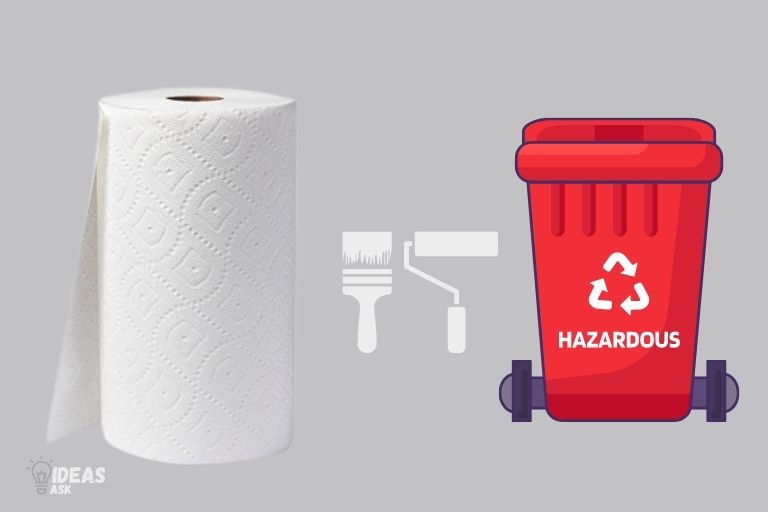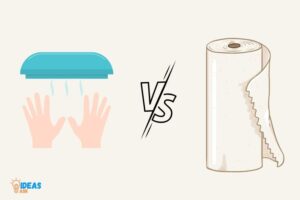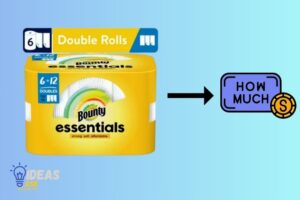How to Dispose of Paper Towels With Paint Thinner? 7 Steps!
To dispose of paper towels with paint thinner, you should first allow the paper towels to completely dry, then place them in a non-flammable container and dispose of them in a hazardous waste facility.
Paint thinner is a hazardous and flammable material, and proper disposal is essential to avoid environmental contamination and fire hazards.
When paper towels have been used to clean up paint thinner, it is important to follow specific steps to ensure safe and responsible disposal.
When handling paper towels with paint thinner, it’s crucial to exercise caution by wearing gloves and ensuring proper ventilation.
After allowing the paper towels to air dry completely, place them in a sealed non-flammable container, such as a metal can.
Do not dispose of them in regular trash bins, as it can pose a fire hazard and contaminate other materials. Instead, take them to a local hazardous waste facility for proper disposal.
Always follow your town or city’s specific guidelines for disposing of hazardous waste materials to ensure the safety of your community and the environment.
7 Steps For Properly Dispose of Paper Towels With Paint Thinner
| Step | Description |
|---|---|
| 1. Gather materials | Collect the paper towels with paint thinner, a non-metallic container, and a plastic bag. |
| 2. Allow paper towels to dry | Lay out the paper towels in a well-ventilated area and let the paint thinner evaporate. |
| 3. Check for dryness | Ensure the paper towels are completely dry and no longer contain any noticeable paint thinner. |
| 4. Place paper towels in container | Place the now dry paper towels in a non-metallic container, such as a cardboard box. |
| 5. Seal the container | Close the container and secure it with tape to avoid any unintended spills or leaks. |
| 6. Bag the container | Place the sealed container in a plastic bag and tie it shut to create an extra layer of protection. |
| 7. Dispose of properly | Dispose of the bagged container in your regular garbage, following local waste disposal regulations. |
Key Takeaway

Five Facts About Disposing of Paper Towels Contaminated with Paint Thinner
Why Throwing Paper Towels With Paint Thinner In The Trash Is Harmful To The Environment
Paint thinner is a household item commonly used for diy projects, and it’s incredibly efficient at removing paint residue and cleaning up spills.
However, using paper towels to clean up paint thinner can be harmful to the environment.
Here’s why:
Introduction To The Environmental Impact Of Throwing Away Paper Towels With Paint Thinner
When paper towels that contain paint thinner are thrown into the trash, they end up in landfills where they can cause significant environmental damage.
The toxins in paint thinner can seep into the ground and contaminate the soil, which ultimately pollutes the water supply. It can also pose a severe threat to local wildlife, and drinking water sources.
Here’s a brief overview:
Overview Of The Chemicals In Paint Thinner And Why They’Re Harmful To The Environment
- Paint thinners are made up of multiple toxic chemicals that can be hazardous to the environment
- These include benzene, toluene, and xylene, which all have hazardous material warnings
- When these chemicals are left to seep into the soil, they can also contaminate the underground water tables, which can spread and contaminate other water sources
- This can be harmful to humans, animals, and plants, and can cause cancer, birth defects, and other health problems in humans and animals alike
How Paper Towels With Paint Thinner Can Contaminate The Local Water Supply
- As mentioned before, paper towels that are contaminated with paint thinner should not be tossed into the trash
- They need to be stored in a sealable container, such as an approved hazardous waste bag, that is labeled correctly
- If disposed of incorrectly they can cause a ripple effect that contaminates the water supply
- As the paint thinner covered paper towels break down, they can leak chemicals into the soil
- This can pollute the water supply and contaminate aquatic life, making it unsafe for drinking, swimming or aquatic life.
Disposing of paper towels contaminated with paint thinner inappropriately is a hazardous practice that pollutes the environment and poses severe health risks.
To protect yourself, animals, and the environment, make sure all hazardous materials are discarded in the correct way.
Start by contacting your local environmental protection agency that can provide instructions on how to dispose of these types of materials properly.
How To Dispose Of Paper Towels With Paint Thinner Safely And Sustainably
How to dispose of paper towels with paint thinner safely and sustainably
If you frequently find yourself working on diy projects, then you know how important it is to have a safe and sustainable way to dispose of paper towels that have been soaked in paint thinner.
Since paper towels are a common item we use in our daily lives, it’s essential to dispose of them safely.
Here’s a guide that will help:
Overview Of Different Disposal Options Beyond The Trash Bin
When it comes to disposing of paper towels with paint thinner, there are a variety of options beyond the trash bin.
Here are some disposal options that you could use for this:
Local hazardous waste disposal services
One of the best ways to dispose of paper towels soaked in paint thinner is by using the local hazardous waste disposal services.
This service is provided by municipal governments, and they usually allow free disposal of hazardous waste, such as paint, thinners, and adhesives.
Landfills
If you can’t use the hazardous waste disposal services, then the next best option is the landfill. Put the paper towels in a sealable plastic bag, and then throw the bag away in the landfill.
Make sure that the bag does not have holes or tears, as this could lead to the hazardous waste leaking out and cause harm to the environment.
Recycling
If the paper towels used don’t have paint, they can be recycled in the normal recycling manner – accordingly, it’s important to ensure that the towel you’re using is suitable for recycling to prevent any pollution or contamination.
Step-By-Step Instructions For Safe And Sustainable Disposal Methods
Here’s how to dispose of paper towels with paint thinner safely and sustainably:
- Soak the paper towels: After using paper towels with paint thinner, let them soak in a container of water for at least 24 hours. This will help dilute the paint and make it easier for disposal.
- Check with your local authorities: Check with your local hazardous waste disposal services or your landfill facility to determine the proper method of disposal.
- Place paper towels in a sealable container: Once you confirm the correct disposal approach, put the paper towels in a sealable container. A jar with a lid can work well for this.
- Drop off at the hazardous waste disposal facility: Finally, drop off the container at your nearest hazardous waste disposal facility or landfill.
Tips For Minimizing Environmental Impact When Disposing Of Paper Towels With Paint Thinner
Here are some tips to help you minimize the environmental impact when disposing of paper towels with paint thinner:
- Use reusable rags: By using reusable rags instead of paper towels, you can greatly reduce the amount of waste generated. As reusable rags can wash with soap and water and also be reused multiple times, they are both environmentally and economically friendly.
- Limit the amount of paint thinner used: By using the minimum amount of paint thinner necessary for your task, you will end up using fewer paper towels and reducing the amount of hazardous waste generated.
- Store hazardous waste properly: When storing hazardous waste, make sure that the containers are sealed and stored in a safe place away from children and pets.
- Beware commercial ads – learn to diy: There are many commercial disposable products that claim to be environmentally friendly, but the better – and more sustainable – approach is to learn how to diy reusable cleaning cloths and rags that will last over time.
By following these safe and sustainable disposal methods, you can protect both yourself and the environment from hazardous waste generated through paper towels stained with paint thinner.
Recycling Paper Towels With Paint Thinner: The Dos And Don’ts
If you’ve ever used paint thinner, you’d understand the importance of using paper towels to clean up the mess. However, disposing of these towels can be a real challenge.
The paint thinner residue on the paper towels can make them hazardous waste materials, not suitable for regular disposal like other household waste.
We’ll explore the dos and don’ts of recycling paper towels with paint thinner and provide some tips on minimizing the environmental impact of this process.
Introduction To The Challenges Of Recycling Paper Towels With Paint Thinner
Paper towels used for cleaning up paint spills or other painting-related activities usually contain hazardous materials like thinners, varnishes, and oils. When these paper towels are discarded, they pose a significant threat to the environment.
The waste management facility will not accept them in their usual form, and they must be treated as hazardous waste. Recycling such towels comes with its own set of challenges.
Here are some things to consider when recycling paper towels with paint thinner:
- Paper towels are not considered to be recyclable materials in many communities.
- The toxic nature of paint thinner remaining on the paper towels makes them hazardous waste.
Specific Dos And Don’ts For Recycling Paper Towels With Paint Thinner
As seen above, recycling paper towels with paint thinner can be a bit tricky.
Here are some specific dos and don’ts to follow when handling this type of waste:
Dos
- Store used paper towels in a metal container with a tight-fitting lid.
- Keep the container closed until the day of disposal.
- Research a hazardous waste disposal unit in your area, and take the container there.
Don’ts
- Do not mix paint thinner-infused paper towels with regular waste.
- Do not wash the paper towels or try to reuse them.
- Do not dispose of them in the regular recycling bin.
Tips For Minimizing Environmental Impact When Recycling Paper Towels With Paint Thinner
Recycling paper towels with paint thinner is essential, but we must minimize the environmental impact of this process.
Here are some tips:
- Use less paint thinner to clean up spills and minimize the amount of hazardous waste produced.
- Research the hazardous waste disposal unit in your area and adhere to their procedures.
- Do not use paper towels for cleaning up minor spills; instead, opt for reusable rags.
- Consider using biodegradable or natural alternatives.
Recycling paper towels with paint thinner is an integral part of proper waste disposal. Knowing the dos and don’ts and implementing eco-friendly tips can minimize the environmental impact while reducing hazardous waste.
Alternatives To Paper Towels To Reduce Environmental Impact
Overview Of Alternative Products To Paper Towels With Paint Thinner
If you’re looking for ways to reduce your environmental impact, using alternatives to paper towels when working with paint thinner is a great place to start.
Here is a brief overview of some alternative products you can use:
- Reusable cloths or rags made of cotton or microfiber
- Compostable or biodegradable paper towels
- Natural sponges made from cellulose or loofah
Pros And Cons Of Each Alternative Product
Before making a switch, let’s take a look at the advantages and disadvantages of each alternative product:
Reusable cloths or rags made of cotton or microfiber:
- Pros: Reusable, durable, can be washed and used again
- Cons: May not absorb liquids as well as paper towels, can stain easily, may require special care when washing
Compostable or biodegradable paper towels:
- Pros: Eco-friendly, can break down in a landfill or compost pile
- Cons: May not be as strong or absorbent as traditional paper towels, cost more
Natural sponges made from cellulose or loofah:
- Pros: Biodegradable, can be washed and used multiple times
- Cons: May not be as effective at absorbing liquids, can wear out quickly with heavy use, may be difficult to find in some areas
Tips For Transitioning To Greener Cleaning Options
Ready to make the switch?
Here are some tips to help you transition to greener cleaning options:
- Research alternative products before making a purchase. Look for products that are eco-friendly and made from sustainable materials.
- Experiment with different products to find what works best for you. Try a variety of paper towel alternatives, for example, to determine the one you like the most.
- Start small by gradually reducing your reliance on paper towels. Use an alternative product for just one task, then gradually switch to using it for all of your cleaning needs.
- Properly dispose of any materials you use when working with paint thinner. Remember to follow local and state guidelines for hazardous waste disposal.
By using alternative products to paper towels when working with paint thinner, you’ll be taking a step toward reducing your environmental impact.
With the right products and a few helpful tips, making the transition to greener cleaning options can be easy and effective.
FAQ On How To Dispose Of Paper Towels With Paint Thinner
How Do You Dispose Of Paper Towels With Paint Thinner?
To dispose of paper towels with paint thinner, place them in a sealed metal container. Label it as hazardous waste and bring it to a hazardous waste disposal facility.
Can You Throw Paper Towels With Paint Thinner In The Garbage?
No, you cannot throw paper towels with paint thinner in the garbage. It is considered hazardous waste and should be disposed of properly.
What Are The Risks Of Improper Disposal Of Paper Towels With Paint Thinner?
Improper disposal of paper towels with paint thinner can contaminate the environment, harm wildlife, and pose health risks to humans.
Where Can You Find Hazardous Waste Disposal Facilities Near You?
You can find hazardous waste disposal facilities near you by contacting your local waste management agency, checking online, or calling your city or county government offices.
Conclusion
Proper disposal of paper towels with paint thinner is a crucial aspect of maintaining a safe and healthy environment. It is advisable to take time to understand the guidelines on how to dispose of these towels effectively.
Always check with your local waste disposal authorities, and follow the established guidelines. Do not throw them in the regular garbage as it can cause a potential fire hazard.
Instead, use a dedicated container to store your used paint thinner-based paper towels until they can be disposed of correctly.
Remember also to take into account the long-term effect on our environment as we must protect it for future generations.
By following these simple tips, you can effectively and safely dispose of paper towels with paint thinner, reducing the risk of harm to yourself and others.




